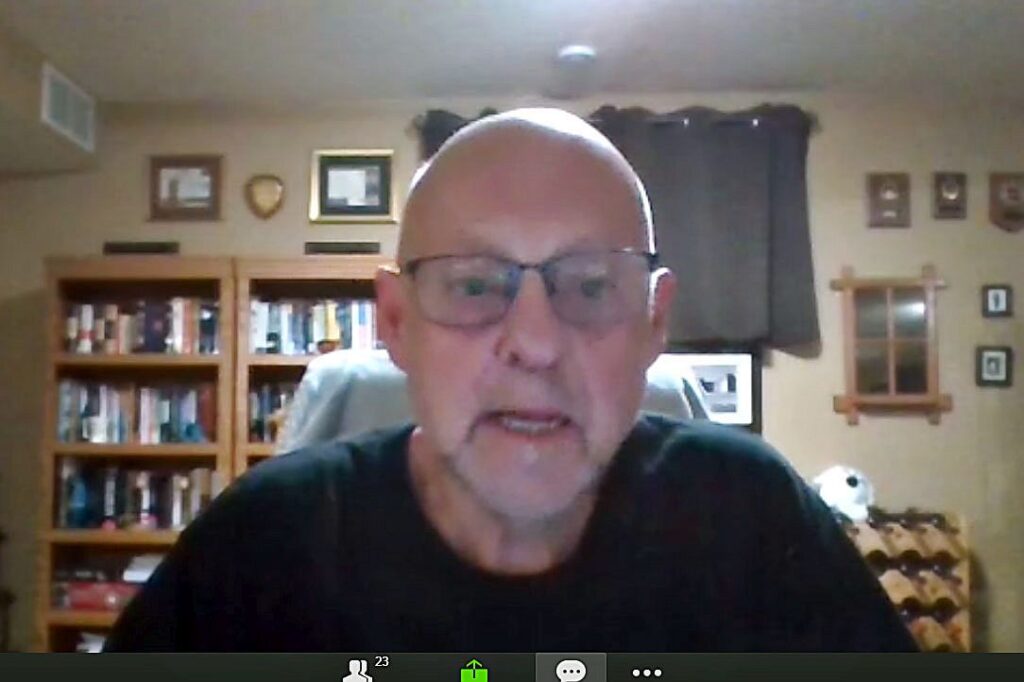
On October 20, the Whitecourt Business Support Network held a virtual networking event featuring Keynote speaker Rick Brick from the University of Alberta’s Department of Strategy, Entrepreneurship and Management. Ahead of Brick’s presentation, Mayor Tom Pickard, fresh off his election win, provided an update from the Town of Whitecourt.
Within twelve hours of winning, he was in the CAO’s office discussing how to keep things seamless so that the business community wouldn’t see disruptions. He spoke of having already talked with big industry players, including those in forestry and oil, and that he had already begun fostering his relationship with MLA Martin Long. He said that he looks forward to working with the new Woodlands County mayor (not yet chosen by the writing of this article).
Mayor Pickard then provided an economic update. “Dahl Drive is nearing completion. That was a 1.6 million dollar project. Sixty percent of the work itself was materials. Inland Concrete did the concrete, so, literally across the road. I don’t know if they used trucks or just extended their delivery spouts,” he chuckled, joking, of course. “That’s as close of a source as we could get.”
He said that E-Construction, the winning bidder for the project, set up a pavement plant in Whitecourt to do the job. “We’ve used all of their resources. All of their crews have been in town now for over eight weeks. They are staying in town, eating in town, and staying in hotels.” A spin-off from the project is that Woodlands County is also using E-Construction for some of their necessary upgrades, as the company was the lowest bidder they received. “They are going to be staying in town for an additional couple of weeks to complete the work with Woodlands. So, for the businesses in town, this is a good stimulus. The money came primarily from our provincial partners as a stimulus that was available to shovel-ready projects. It’s a significant infusion of cash into our community, especially at a time when we so desperately need it.”
When asked for clarification on what it means to take the lowest bidder for a project, Mayor Pickard explained that there is a list of criteria that companies need to meet to be considered for a project. The lowest bidder who meets the criteria is often selected. “Who will have the lowest bid on the standard? That’s established by our engineers and our administration. I think if E-Construction was here, and they knew they were setting up a pavement plant for Dahl Drive, they would certainly be in a position to be very competitive (for a project in Woodlands) if they don’t have to move that plant. It’s a win for the entire community that they are here and got this job. It met the standards that were established, and it’s great that they are staying in town for a few more weeks to spend their out-of-town money in town.”
Other updates that Mayor Pickard spoke about included Whitecourt Dry Cleaners getting back to business in their old spot on 50 Street and improvements coming to the Court House. “Whitecourt Ford is going to be doing some storm sewer upgrades, so you’ll see some disruption on the street, and West Whitecourt Petro Canada is increasing the size of their driveway.” There are also smaller projects approved in the community, such as decks and garages.
“It’s my intention that once our Economic Development boards are in place that they will be part of this process to ensure that we are sending the message that we are open for business. We are welcoming business and that we want everyone in the Whitecourt region to succeed.” To the new council, Mayor Pickard said he is looking forward to the next four years. “We’ve got a good mix of new and old councillors. I think we are ready to go to work for Whitecourt and our region.”
Following the mayor’s update, Rick Brick began his presentation. Communication between employers and employees was a big focus point. “It’s a tough thing to do because the information we have changes as each new study comes out or each new variant comes out, or the process changes. The employer, like government and like everybody else, is having a problem trying to give the best information they can while understanding that it’s best only in the current context.”
Brick explained that employees are obligated to communicate with their employer. “It is not a one-way street. Communication is meant to be two-directional.” He said that part of communication is to be understanding of each other. “Information is not perfect. We’ve got people with differing points of view and simply dismissing those points of view is usually of little benefit. It’s much better to try and deal with the differing views and see if we can come to some level of understanding. So, communication becomes quite key in what we are doing. It’s absolutely critical.”
As a Human Resources person, Brick said it’s impossible to overcommunicate when talking to staff. “By the time you are sick of hearing it come out of your mouth, employees are finally starting to internalize it and hear it. There’s a lot of employee angst out there. There’s a lot of fear. It’s an unknown situation to some extent, so that is understandable. But the reality is the same’s true of the employer. The same’s true of your customers and clients. We are all kind of in that same boat together.” To catch future free virtual BSN events, visit www.albertabsn.ca.







More Stories
Community spirit shines at large-scale youth baseball event
Birthday party chaos sung beautifully by Pumpjack Players’ youth in spring musical
Gearing up for another season of cars, cruising and camaraderie